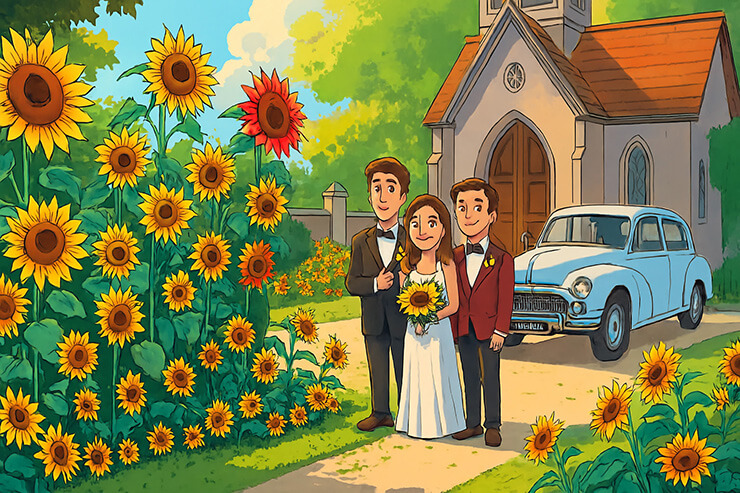Read by Michael Flamel

It was tradition—sunflowers, always sunflowers—planted proudly at the front edge of the church garden. A sight to behold.
Verne, a retired timber faller and stalwart of the church, had started the garden on church-owned land with a noble mission: to donate fresh veggies to the local food bank. Every year, he planted a row of sunflowers along the front, turning the garden into a cheerful beacon that delighted anyone who saw it. After 11 years of tending to the garden, Verne decided it was time for his own “retirement from retirement” and handed the reins to me.
When I took over, several folks came up to me with that look that said, “You better not mess this up.” And when they asked about the sunflowers, I knew I had to keep the tradition alive. It was like the unspoken rule of garden inheritance.
Our garden sits behind the church, about 50 yards from the street, but that sunflower row is hard to miss. With blooms standing as tall as 10 feet, I figured it was a good way to keep curious passersby from wandering in uninvited. Over time, I’d harvest seeds from the best blooms, adding new varieties each year—American Giant, Ring o’ Fire, Red Sun—you name it. At peak season, I estimated we had about 400 to 500 blossoms turning their faces to the sun. Quite the sight, even if I say so myself.
One sunny afternoon, while I was elbow-deep in weeding, a car pulled in, and a couple stepped out. They hesitated just at the edge of the parking lot. Garden etiquette, I thought. They know the code: you don’t just barge in uninvited. I waved them over, and they introduced themselves as Mike and Joan.
They had seen the sunflowers from the road and asked if I might sell them a few. I chuckled at their formality, but curiosity got the best of me. “How many are we talking about?” I asked.
“Twenty-four,” Mike replied with the seriousness of a man placing an order for lumber, not flowers.
I nearly dropped my hoe. “Twenty-four? What’s the occasion—sunflower festival in town?”
Mike laughed and explained that their daughter was getting married the following week, and she wanted sunflowers for the ceremony. They had scoured all the florists in town, but not a petal of sunflowers could be found. Then they spotted my row of sunshine from the street and hoped I might help them out.
I scratched my head and then, with as much gravitas as Verne might’ve mustered, I said, “Well, I won’t sell you sunflowers.” Pause for dramatic effect.
“I’ll give you sunflowers,” I added, smiling.
I showed them how to pluck a few here and there without leaving a giant gap in the row—so my sunflower parade wouldn’t look like it had been ransacked. They were grateful, and we set a time for them to pick the flowers closer to the big day.
A week later, I was back in the garden when Mike returned. He parked his car and like a good garden guest, waited to be invited in. As he strolled over, he asked, “How grows your garden?”
“It’s blooming along just fine,” I replied. “How was the wedding?”
“Beautiful,” he said, beaming. “The sunflowers were a huge hit, and our daughter was thrilled.”
With that, Mike shook my hand—a classic handshake—but as he pulled away, I felt a little something slip into my palm. A $20 bill, folded discreetly.
I chuckled to myself as he walked back to his car, waving goodbye. So much for not selling sunflowers. Maybe I am a sunflower salesman after all—just don’t tell Verne. ❖
About the author: Stan Schmidt planted his first backyard garden in 1973 and have been growing ever since. After a career in law enforcement and other community roles, he spent 18 years tending the large garden at his church, earning a Master Gardener certification along the way. From backyard plots to a 1/3-acre community garden, he has shared his passion for plants, soil, and the joy of growing with others. Though Parkinson’s disease has slowed his pace, his love for gardening remains deeply rooted.


 Previous
Previous

